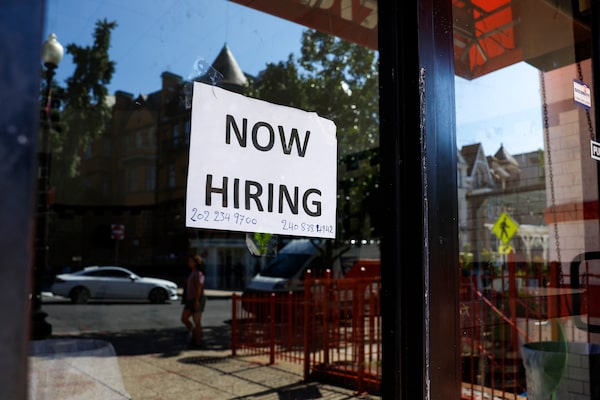
A now hiring sign on a storefront in Washington, on Oct. 7, 2022.Anna Moneymaker/Getty Images
The number of Americans filing new claims for unemployment benefits unexpectedly fell last week, pointing to another month of solid job growth and continued labour market tightness despite efforts by the Federal Reserve to cool demand for workers.
The weekly jobless claims report from the Labor Department on Thursday likely does not change expectations that the U.S. central bank will further scale back the size of its interest rate increases next month. It, however, poured cold water on financial market hopes that the Fed would pause its fastest rate hiking cycle since the 1980s, which had been fanned by a slump in retail sales in December and a retreat in inflation.
“A low level of layoffs indicates that demand for workers remains strong and labour market conditions remain tight,” said Rubeela Farooqi, chief U.S. economist at High Frequency Economics in White Plains, New York. “Facing workers shortages and challenges in hiring, businesses appear to be reluctant to reduce their head counts.”
Initial claims for state unemployment benefits dropped 15,000 to a seasonally adjusted 190,000 for the week ended Jan. 14, the lowest level since September. Economists polled by Reuters had forecast 214,000 claims for the latest week.
Part of the third straight weekly drop in claims likely reflected continuing challenges in adjusting the data for seasonal fluctuations at the start of the year.
But through the seasonal volatility, claims have remained at levels consistent with a tight labour market even as layoffs have accelerated in the technology industry and interest rate-sensitive sectors like finance and housing.
Unadjusted claims dropped by 53,582 to 285,575 last week. There was a jump in claims for California, which were estimated. That was offset by sizable declines in Georgia, Michigan, New Jersey, Wisconsin, New York and Texas.
Microsoft Corp said on Wednesday it would eliminate 10,000 jobs, joining cloud-computing rival Amazon.com, which is pushing ahead with a plan to lay off 18,000 employees. Economists cautioned against reading the technology layoffs as flagging a deterioration in labour market conditions, arguing that these companies were rightsizing after over-hiring during the COVID-19 pandemic.
“The tech sector is just getting back to where they were in 2020 or 2021, which I don’t think is a bad situation,” said John Blevins, a guest lecturer at Cornell University’s SC Johnson College of Business. “It’s still a huge work force. These people being let go at these major tech firms will get new replacement jobs almost immediately.”
Outside the technology industry, economists say companies are generally reluctant to send workers home after difficulties finding labour during the pandemic. They expect companies to cut back on hiring before resorting to layoffs.
Indeed, the Fed’s latest “Beige Book” report on Wednesday showed that “many firms hesitated to lay off employees even as demand for their goods and services slowed and planned to reduce head count through attrition if needed.”
U.S. stocks opened lower on Thursday. The dollar was slightly weaker against a basket of currencies. U.S. Treasury prices fell.
The Fed last year raised its policy rate by 425 basis points from near zero to the current 4.25 per cent-4.50 per cent range, the highest since late 2007. In December, it projected at least an additional 75 basis points of hikes in borrowing costs by the end of 2023.
The claims data released on Thursday covered the period during which the government surveyed businesses for the nonfarm payrolls component of January’s employment report.
Claims decreased between the December and January survey weeks. The economy added 223,000 jobs in January.
Data next week on the number of people receiving benefits after an initial week of aid, a proxy for hiring, will shed more light on employment growth in January. In the week ending Jan. 7, the so-called continuing claims rose 17,000 to 1.647 million, the claims report showed.
Tighter monetary policy is continuing to strangle the housing market. A separate report from the Commerce Department on Thursday showed single-family home building rebounded in December, but permits for future construction dropped to more than a 2-1/2-year low, pointing to weakness ahead.
Single-family housing starts, which account for the bulk of home building, increased 11.3 per cent to a seasonally adjusted annual rate of 909,000 units last month, the highest level since August. Starts for housing projects with five units or more tumbled 18.9 per cent to a rate of 463,000 units.
Overall housing starts decreased 1.4 per cent to a rate of 1.382 million units last month. Housing starts fell 3.0 per cent in 2022.
Single-family building permits declined 6.5 per cent to a rate of 730,000 units, the lowest level since April 2020. Outside the pandemic plunge, these permits were the lowest since February 2016. Building permits for housing projects with five units or more increased 7.1 per cent to a rate of 555,000 units.
Overall building permits fell 1.6 per cent to a rate of 1.330 million units. Permits dropped 5.0 per cent in 2022.
“The housing market recession will likely continue through most of 2023,” said Abbey Omodunbi, a senior economist at PNC Financial in Pittsburgh, Pennsylvania.